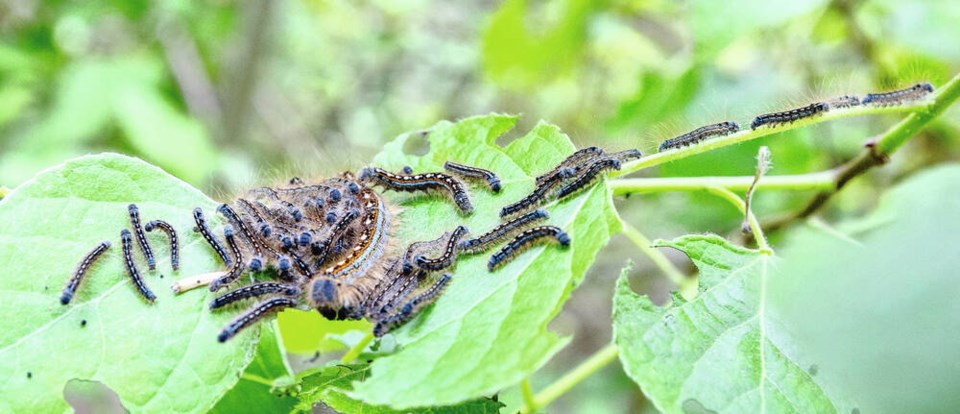My granddaughter Lily likes me to read her Eric Carle’s 1969 horror story The Very Hungry Caterpillar. If you are not familiar with the celebrated children’s picture book, you probably sleep well at night and have a sunny disposition and good complexion.
The plot follows a very hungry caterpillar that eats its way through quite a bit of expensive garden landscaping before becoming a giant, sentient moth that terrorizes the good people of Tokyo.
More than 50 million copies of the book have been sold in 60 different languages, despite its crappy-but-iconic art style featuring collage artwork and holes in the pages where the caterpillar “ate” through. OK, it was the late 1960s — even elementary school librarians were tripping balls on psychedelic mushrooms.
The real horror of the story is how it is playing out right now in your backyard. I am reminded of famous insect biologist Oscar Wilde, who said: “Life imitates art far more than art imitates life.” I suspect he said this after reading The Very Hungry Caterpillar, or perhaps after looking around for two minutes.
To wit: Vancouver Island is being overrun by Very Hungry Caterpillars. They are gross and scary and I don’t like it.
I do like trees. Caterpillars voraciously feed on delicious trees in most parts of southern Canada. Sorry, that should read deciduous trees in most parts of southern Canada, which is the only part of Canada where trees grow.
The Western tent caterpillar favours willow, poplar, apple, plum, cherry and oak trees, by which I mean it likes to strip bare and then lay gross clusters of eggs that turn into wriggling masses of … OK, deep breaths.
There are 64 species of caterpillars found in British Columbia. The most common is the tent caterpillar, of which there are three species, all gross, all hungry, all the time.
The Government of Canada says that since records began in 1646, “periodic outbreaks” of these caterpillars happen about every 10 years.
The Government of Canada also says, under the unnecessary heading Should I be concerned?, “Since tent caterpillars are native to North America, insect parasites and natural predators like birds and rodents control a certain amount of the population.”
It means we should leave caterpillars alone to be eaten by the locals, unless the infestation is “severe.” It does not address the fact that four caterpillars on a large-sized tree is already two or three caterpillars beyond the severe infestation level.
Apart from open-mouthed cyclists, very few mammals actually eat caterpillars, probably because mammals have larger brains than birds and reptiles and [insert name of coworker for hilarious burn!]. However, some surprise mammals such as bats and whales eat both tent caterpillars and the moths those ones don’t grow into.
Wait, what? That can’t be right. Uh, checking my notes … Hmmm, what is clear is that whales are mammals … Also, bats eat tent caterpillars and moths. I’m going to fill in a few gaps in the science to say bats and whales are our last best defense against tent caterpillars.
Flamethrowers are probably our first best defense against caterpillars, but there are always unintended consequences when you hand out napalm, willy-nilly. The same is true for pesticides.
When I was a boy, neighbourhood dads sprayed all kinds of chemicals around the yard like aftershave before the semi-annual date night with their wives. Everybody got bad cancers and died and that’s how we liked it.
Today those chemicals are verboten, unless you are a) already involved in a land war in Asia; or b) plagued with gypsy moths.
Apologies for saying gypsy moths. That is the bad old name that only bad old people use. The new name is spongy moth, or if you like to throw around a little scientific lingo, Lymantria moth. Lymantria is the species’ genus name, which means “dirty, thieving gypsies” in Latin.
This year, the B.C. government is conducting an aerial insecticide spraying program to target these invasive moths (remember, moths are winged caterpillars). Spraying is planned for Greater Victoria and the Vancouver Island communities of Courtenay, Campbell River and Port Alberni “to prevent the moths from becoming permanently established.”
Last year on the Island, they sprayed around View Royal, Nanoose Bay and Cowichan Lake “to prevent the moths from becoming permanently established.”
Today, we are less cavalier with dangerous, carcinogenic chemicals. What is being sprayed is a biological insecticide known as Foray 48B, which is used in organic farming and has been approved for use in Canada since 1961.
It’s still a losing game, but what are we going to do? It is summertime, the season when all Real Canadians™ lose our minds because we get more than 14 minutes of sunshine per day.
We are very busy outside right now, putting our barbecues and our livers through their paces, and we don’t have time to be concerned with the more freakish and disgusting aspects of the circle of life.
Perhaps the government could combine spraying Foray 48B with whales. If a single whale gets into the forest behind my house, those caterpillars are goners.
On further reflection, there may be logistical issues with the idea, but what about bats? Bats were probably responsible for COVID-19, or at least had a dirty claw in it. They owe us.
I want to be paid back in very hungry dead caterpillars.
>>> To comment on this article, write a letter to the editor: [email protected]


